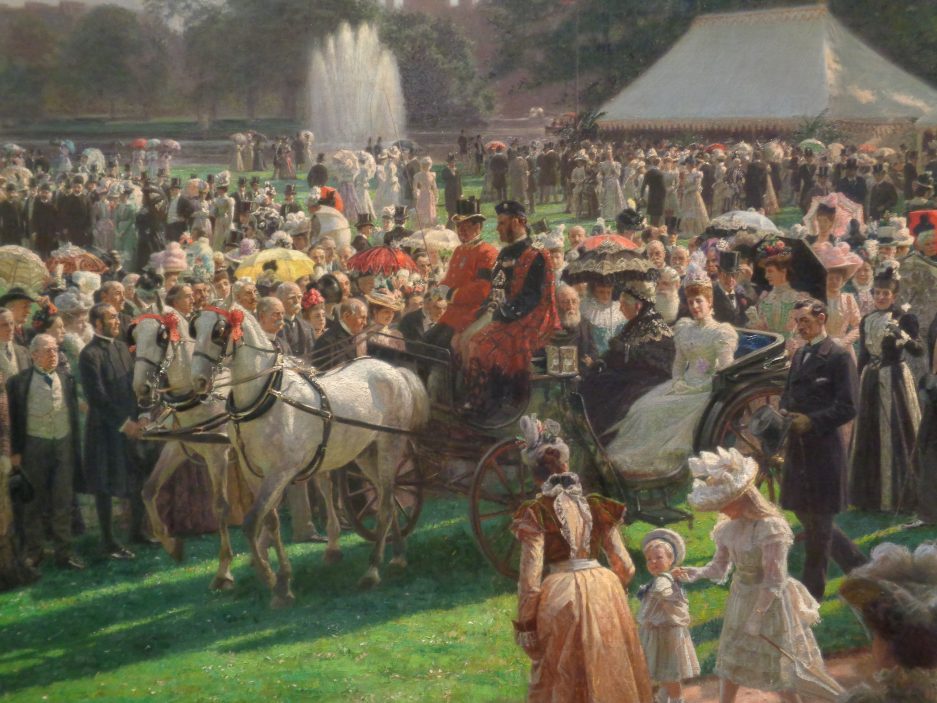After the signing of the Treaty of Versailles in June 1919 the Prime Minister David Lloyd George suggested that a Peace Parade should be held to celebrate the signing and the end of the Great War; not only to celebrate victory and the coming of peace but commemorate the dead and make sense of the sacrifice of over a million Imperial soldiers. It was felt that the parade needed a central object and a symbolic heart on which people could focus their attention; in Lloyd George’s words in early July 1919 “a point of homage to stand as a symbol of remembrance worthy of the reverent salute of an Empire mourning for its million dead;”* and he asked architect Edwin Lutyens to design a monument to be ready for the parade on 19 July. It was to be non-denominational and carry no Christian symbolism. This decision was opposed by the Church, but Lutyens was aware from his work with the IWGC that many soldiers who had fought and died for the British Empire were not of the Christian faith, and he wanted his memorial to encompass the sacrifice of all.
Lutyens had already discussed the building of a suitable monument with the Commissioner of the Board of Works, and he had a design ready. The speed of the building meant that it was built of materials easy to use – plaster and wood – but the structure was not meant to be permanent. Lutyens called it a Cenotaph – from the Greek meaning ‘empty tomb.’ It was ready for the Peace Parade ceremonies and the official unveiling by George V.


Once the official ceremonies in July 1919 were over, people started to project their own grief onto the monument – it provided a symbolic coffin in which people could imagine laying their dead and where they could come to grieve. As Juliet Nicolson describes in The Great Silence:
“To be in the silent presence of the Cenotaph, the mind paradoxically was free to express anything it chose…lacking any inner substance of its own, it seemed to be the silence of grief made visible the absence of the missing men made real…The Morning Post noted that ‘Near the Memorial there were moments of silence when the dead seemed very near. “
The temporary Cenotaph became a place of pilgrimage, ever since its unveiling heaped with wreaths, bouquets and floral tributes laid ten feet high, with people queueing for hours to leave their flowers; poignantly one little boy who brought flowers saw it as if standing in its own garden cried out “Oh mummy, see what a lovely garden my daddy’s got!”
Officialdom was taken by surprise at the depth of the emotional and spiritual public response, as officialdom so very often is. First, it was suggested that the temporary Cenotaph should be moved. Then the Commissioner of Works, Sir Alfred Mond, irritated by the smell of decaying flowers in the hot summer of 1919, suggested that the laying of flowers should be severely restricted – too messy and too popular. The Cenotaph was too mournful a memorial, it disrupted the traffic, which was missing the point. Lutyens had placed it where it was deliberately, to intrude upon day to day life and make people think about what it represented. It was not meant to be triumphal and celebrate victory, it was a memorial to what that victory had entailed in terms of human sacrifice – men dead, maimed, missing, women widowed, children fatherless, parents bereft. Where it stands is a permanent reminder even now to government and passers-by of that cost, both in 1914-1918 and later.
Demands by the public and MPs to make the Cenotaph a permanent memorial started almost as soon as the Peace Parade was over, and Lutyens was commissioned to recast his memorial in Portland stone less than two weeks after the parade.
The Cenotaph was finally unveiled by the King on Armistice Day 11 November 1920 just before the cortege of the Unknown Warrior passed on its way to Westminster Abbey. Such was the hush as people waited to see the unveiling that onlookers recalled the rustling of autumn leaves as the only sound. Described by one journalist as ‘grave, severe and beautiful,’ this memorial did not hold a body or exalt a victorious general. It had no statues of soldiers trampling fallen enemies, no boasting of battles won, or lands conquered; nothing that might disturb or alienate the onlooker. It held three words only – The Glorious Dead – and the only decorations were carved wreaths of ribbon and three flags along each flank (Lutyens wanted these to be carved in stone but was overruled). The lack of imagery or religious symbolism allowed each mourner to project their own personal grief and derive their own meaning and consolation. In the words of one writer, Richard van Emden: “with the decision to leave the remains of all who had died where they lay overseas, the Cenotaph was carefully representative of the nation’s acceptance that there would be no bodies to bury at home.” The Church establishment did not approve at all of this secularism – one reason why it was so ready to accept the idea of the burial of the Unknown Warrior in Westminster Abbey as an alternative shrine.

*The loss to the British Empire was actually 1,104,890 dead. Commentators at Armistice and later Remembrance Sunday broadcasts used a visual metaphor to indicate the magnitude of the loss if the dead of the Great War marched in rows of four past the Cenotaph, the head of the column would be in Whitehall while the tail would still be in Durham (270 miles/448 km).








